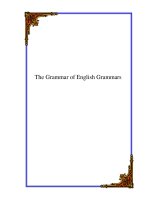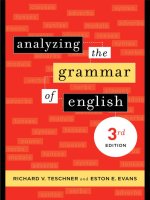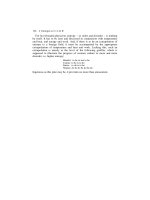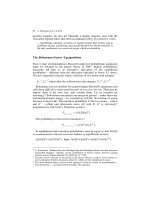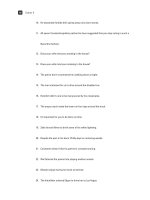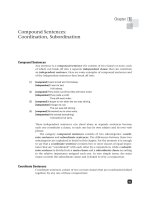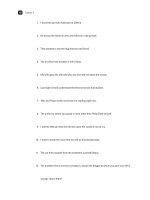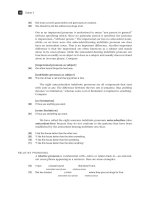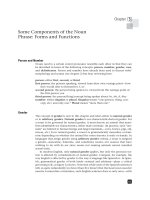Analyzing the Grammar of English Third Edition phần 1 pps
Bạn đang xem bản rút gọn của tài liệu. Xem và tải ngay bản đầy đủ của tài liệu tại đây (332.75 KB, 26 trang )
ANALYZING THE GRAMMAR OF ENGLISH
00i-xiv.Teschner.FM.indd i00i-xiv.Teschner.FM.indd i 4/2/07 6:02:29 PM4/2/07 6:02:29 PM
Georgetown University Press | Washington, D.C.
Richard V. Teschner
and
Eston E. Evans
Analyzing
the Grammar
of English
Third Edition
00i-xiv.Teschner.FM.indd iii00i-xiv.Teschner.FM.indd iii 4/2/07 6:02:31 PM4/2/07 6:02:31 PM
As of January 1, 2007, 13-digit ISBN numbers have
replaced the 10-digit system.
13-digit Paperback: 978-1-58901-166-3
10-digit Paperback: 1-58901-166-X
Georgetown University Press, Washington, D.C.
© 2007 by Georgetown University Press. All rights reserved.
No part of this book may be reproduced or utilized in any form
or by any means, electronic or mechanical, including photocopying
and recording, or by any information storage and retrieval system,
without permission in writing from the publisher.
Library of Congress Cataloging-in-Publication Data
Teschner, Richard V.
Analyzing the grammar of English / Richard V. Teschner and
Eston E. Evans.—3rd ed.
p. cm.
Includes index.
ISBN-13: 978-1-58901-166-3 (pbk. : alk. paper)
ISBN-10: 1-58901-166-X (pbk. : alk. paper)
1. English language—Grammar. I. Evans, Eston Earl,
1940– II. Title.
PE1112.T48 2007
425–dc22
2006031186
This book is printed on acid-free paper meeting the requirements
of the American National Standard for Permanence in Paper for
Printed Library Materials.
14 13 12 11 10 09 08 07 9 8 7 6 5 4 3 2
First printing
Printed in the United States of America
00i-xiv.Teschner.FM.indd iv00i-xiv.Teschner.FM.indd iv 4/2/07 6:02:32 PM4/2/07 6:02:32 PM
v
Contents
Figures ix
Acknowledgments xi
Introduction xiii
1 Utterances, Sentences, Clauses, and Phrases 1
The Most Important Parts of Speech 5
Noun 5
Verb 7
Adjective 10
Adverb 12
Pronoun 13
Determiner 14
Quantifier 14
Preposition 14
Case 16
Subject Case 17
Genitive/Possessive Case 17
Object Case and Subject Case 17
Sounds: Phones, Phonemes, and Allophones 19
Forms: Morphemes and Allomorphs 24
/z/—A Highly Productive English Morpheme 25
/d/—Another Highly Productive English Morpheme 28
Problems with /d/ 29
Note 30
2 Verbs, Tenses, Forms, and Functions 31
Conjugating a Verb 31
Regular Verbs 31
Irregular Verbs 32
The Nine Morphological Patterns of Irregular Verbs 33
Verb Tenses and Auxiliary Verbs: The Nonmodal Auxiliaries (Do, Be, Have) and
the Modal Auxiliaries 38
The Simple Tenses 38
The Importance of the Subject 38
Imperatives, the Present Tense, and the Excluded Subject Pronoun 39
The Compound Tenses: Present and Past 39
00i-xiv.Teschner.FM.indd v00i-xiv.Teschner.FM.indd v 4/2/07 6:02:33 PM4/2/07 6:02:33 PM
vi
The Compound Tenses: Future and Conditional 40
Future Tense 41
Conditional Tense 41
Verb Tenses’ Meanings and Uses 45
The Present Tense 46
The Past Tense 48
The Future and the Conditional Tenses 48
The Progressive Tenses: Present/Past/Future/Conditional 50
The Perfect Tenses: Present/Past/Future/Conditional 50
Notes 54
3 Basic Structures, Questions, Do-Insertion, Negation, Auxiliaries,
Responses, Emphasis, Contraction 55
The Five Basic Structures 55
Two Different Types of Questions 55
Do-Insertion 55
Negation 56
The Role of the First Auxiliary (aux) 56
Nonmodal Auxiliaries Be/Do/Have Can also Be Used as Lexical Verbs 57
Wh-Words as Subjects vs. Wh-Words as Objects 58
Selection Questions 63
Declarative Questions 63
Echo Questions 64
Tag Questions 64
Invariant Tags 65
Elliptical Responses 65
Emphasis and Emphatic Structures 68
Contractions: A Summing Up 71
Contracting Not 71
Nonmodal Auxiliaries’ Contractions 71
Modal Auxiliaries’ Contractions 74
Note 77
4 Modals, Prepositional and Particle Verbs, Transitivity and Voice, and Conditionality 79
Modals and Perimodals 79
Perimodals 81
The Meanings of Modals and Perimodals 82
Two-Word Verbs: Prepositional Verbs vs. Particle Verbs 89
General Comments about Prepositional vs. Particle Verbs 92
Transitivity: Active Voice, Passive Voice 95
Intransitive Verbs and “Voice” 100
Transitive Verbs in Superficially Intransitive Constructions 100
Normally Transitive Verbs used Intransitively 101
Real-World Use of the English Passive: Pragmatic Constraints and
Agent Phrase Addition 103
GET Passives 104
Conditionality 106
Contents
00i-xiv.Teschner.FM.indd vi00i-xiv.Teschner.FM.indd vi 4/2/07 6:02:35 PM4/2/07 6:02:35 PM
vii
5 Some Components of the Noun Phrase: Forms and Functions 113
Person and Number 113
Gender 113
Case 114
Expressing Possession: Genitives and Partitives 116
Partitive-Genitive Constructions 117
Determiners, Common/Proper Nouns, and Mass/Count Nouns 121
Determiners 121
Articles, Definiteness, and Specificity 121
Common and Proper Nouns 123
Mass Nouns and Count Nouns 123
Mass-to-Count Shifts 124
Dual-Function Nouns: Nouns That Are Both Mass and Count 125
Pronouns 128
The Morphology of Personal Pronouns 131
Reflexive Pronouns 131
Reciprocal Constructions 132
Demonstratives 135
Demonstrative Pronouns 136
Indefinite Pronouns 137
Relative Pronouns 138
Interrogative Pronouns 139
Pro-Words: Pronoun-Like Words for Clauses, Phrases, Adjectives, and Adverbs 140
Note 142
6 Adjectives and Relative Clauses 143
Attributive and Predicate Adjectives: Identification and Syntax 143
The Syntax of Prenominal Attributive Adjectives 147
Adjectives and Adverbs: Comparative and Superlative Forms 148
Changing Equatives to Comparatives: When to Use More and When to Use -er 148
The Morphology of Superlatives: When to Use -est and When to Use Most 150
Equatives, Comparatives, and Superlatives: Their Structures and Meanings 150
Equatives with Comparative Meanings and Equatives and Comparatives with
Superlative Meanings 153
Relative Clauses, Relative Pronouns, and Their Antecedents 155
When to Use Who and When to Use Whom 157
Deleting Relative Pronouns: Creating Gaps and the Process of Gapping 157
The Twenty Types of Relative Clauses 158
How to Use the Example Sentences in Figure 6b 158
The Relativization of the Possessive Determiner Whose 159
Restrictive and Nonrestrictive (Relative) Clauses 165
Relative Pronoun Clauses with Present Participles/Gerunds and with
Past Participles 168
Notes 170
7 Adverbs, It and There Referentials and Nonreferentials, and Fronting 171
Adverbs 171
It as a Referential, It as a Nonreferential 174
Contents
00i-xiv.Teschner.FM.indd vii00i-xiv.Teschner.FM.indd vii 4/2/07 6:02:36 PM4/2/07 6:02:36 PM
viii
Adverb Referential There, Existence-Marking Nonreferential There 175
Emphasis by Peak Stressing, Solo Fronting, or Cleft Fronting 178
Note 182
8 Compound Sentences: Coordination, Subordination 183
Compound Sentences 183
Coordinate Sentences 183
Subordinate Sentences 188
Clausal Adverb Complements 190
Clausal Object or Subject Complements 191
Clausal Predicate Nominative Complements 192
Clausal Noun Complements 192
Clausal Adjective Complements 193
Tenseless Complements 195
Infinitives and Gerunds as Tenseless Verb Complements 195
The That-Clause 197
The Infinitive Complement 197
Equi-Deletion 198
Raising to Object 198
Infinitive Complement with Equi-Deletion 198
Infinitive Complement with Raising to Object 199
Gerund Complement 201
Gerund Complement with Equi-Deletion 201
Gerund Complement with Raising to Object 201
Gerund Complement with Raising to Possessive 202
Purpose Complements 203
Miscellaneous Complementation Patterns 204
Summary of All Clausal Complementation Patterns 204
Appendix 211
Glossary of Terms 219
Index 229
Contents
00i-xiv.Teschner.FM.indd viii00i-xiv.Teschner.FM.indd viii 4/2/07 6:02:37 PM4/2/07 6:02:37 PM
ix
Figures
1a Utterance, Sentence, and Clause 2
1b The Twelve English Vowel Phonemes 20
1c Words Exemplifying the English Vowel Phonemes’ Sounds 21
1d Correlation of Stress and Schwa 21
1e Voiceless and Voiced Consonant Pairs 22
1f The Twenty-Four English Consonant Phonemes 22
2a The Fourteen Active Voice Compound (and the Two Simple)
Verb Tenses 42
3a Presence of do-Insertion 56
3b Absence of do-Insertion 57
3c Tag Questions: The Tree 65
3d Tag Questions: The Outline 65
3e Tag Questions: The Examples and the Explanations 66
4a The Perimodals 81
4b The Eight Modality Types and Their Representative Modal Verbs 83
4c Simple and Compound Tenses in the Passive Voice 96
4d The Syntax of GET Passives and BE Passives 104
4e The Various Types of Conditionality 107
5a Grammatical Gender: English Compared with Spanish 114
5b Genitive versus Partitive in Expressions of Possession 115
5c The Mass Noun/Count Noun Distinction: Potential Environments 126
5d The English Personal Pronoun System 130
5e The English Demonstratives 136
6a The Ordering of Prenominal Attributive Adjectives 147
6b The Twenty Types of Relative Clauses 159
7a Different Ways of Expressing Emphasis 179
8a The Structure of a Coordinate Sentence 189
8b The Structure of a Subordinate Sentence 189
8c The Structure of Multiple Complementing with that-Clauses 191
8d The Structure of an Equi-Deletion 198
8e Equi-Deletion Complements in the Passive Voice 199
8f Infinitive Complement with Raising to Object 200
00i-xiv.Teschner.FM.indd ix00i-xiv.Teschner.FM.indd ix 4/2/07 6:02:38 PM4/2/07 6:02:38 PM
xi
Acknowledgments
The authors heartily wish to thank the many anonymous users and reviewers
for their critiques and evaluations of the second edition, evaluations that have
aided us greatly in the revisions that gave rise to the present work. And our very
special thanks go out to Prof. Rebecca Babcock of the University of Texas of the
Permian Basin, who on several occasions has generously sent us dozens of help-
ful and useful suggestions; Michael Bromka (Carlsbad, New Mexico), a friend of
the textbook since 1990; and Julian Tarango (El Paso, Texas), a real-world lodestar
in language and living alike.
00i-xiv.Teschner.FM.indd xi00i-xiv.Teschner.FM.indd xi 4/2/07 6:02:41 PM4/2/07 6:02:41 PM
xiii
Introduction
Analyzing the Grammar of English (which we abbreviate AGE) is an analysis of the
grammar of a particular language (English) and not an introduction to linguistics
whose examples end up coming from English. A textbook and not a reference
grammar, AGE also constitutes a reasonably brief examination of its topics that
the authors’ classroom experience has shown can be completed in a fifteen-week
semester. AGE keeps end-of-chapter notes to a minimum and attempts no biblio-
graphical coverage. On the other hand, exercises abound—even more so in the
present edition—that complement the text as fully as possible and are prefaced
in most cases by examples of how to proceed. (AGE also contains a lengthy glos-
sary of terms—new to this edition—along with an index of topics.)
AGE’s third edition has been partly redesigned so it can better function in
skills-building classes—developmental English or advanced ESOL—and serve its
users as a review grammar as well as a course in the morphosyntactic analysis
of English. So while AGE’s main target populations continue to be majors in
linguistics or its allied disciplines (English, communication, education, etc.) for
whom a course in English grammatical analysis will always form part of a well-
designed curriculum, AGE can now also be used by students who are not as far
along in their college careers and whose needs are developmental or allolingual
rather than strictly analytical or pedagogical. (Several chapters of the third edi-
tion have been revised extensively to achieve this; this is especially true of the
largely rewritten chapter 1.)
In essence, grammar is the analysis of language elements that convey mean-
ing. These elements include sounds (phonetics and phonology), individual words
(the lexicon), the constituent meaningful elements of words (morphology), the
arrangement of words into phrases, clauses, and sentences (syntax), accent and
stress (prosody), and the appropriate overall application of all these things in a
given situation (pragmatics). Humans rarely analyze their language in any formal
way, at least not unless they are made to do so by language-conscious parents
or instructors. In days of yore, teachers sought to advance children’s linguistic
skills—not only reading and writing, but speaking as well—by chiding them to
monitor their language and follow certain norms when using it. This sort of lan-
guage activity is known as prescriptive grammar or prescriptivism. Children
were expected to impose conscious rules of language usage on the unanalyzed
language they already spoke proficiently. To do so, they were often told to change
the way they spoke, and they were told that to avoid being looked down on (or
stigmatized) as uneducated (or trashy, rude, dumb, coarse, etc.) by using “bad
00i-xiv.Teschner.FM.indd xiii00i-xiv.Teschner.FM.indd xiii 4/2/07 6:02:42 PM4/2/07 6:02:42 PM
xiv
grammar,” they must learn and conform to the standards that were said to typify
the language of the most prestigious speakers of their wider speech community.
(The standards have many names, including the judgmental “good grammar”;
we call them standard written English.)
In contrast to prescriptive grammar is the form of language analysis known
as descriptive grammar; this is the type of analysis that largely informs the
present textbook. Descriptive grammar presents the facts about a language as it
is actually spoken. According to descriptivist tenets an utterance is grammati-
cal if a language’s native speakers routinely say it and other native speakers of
that language are able to understand it. (Whether the native speaker’s utterance
is stigmatized is an entirely separate issue.) When describing language thus, we
ignore for the moment the fact that all native speakers make occasional perfor-
mance errors, or slips of the tongue; these performance errors are caused by such
inadvertent factors as haste, tension, fatigue, inattention, or inebriation.
One example of the way descriptive analysis works is how it deals with Eng-
lish sounds. For instance, almost all native speakers of English produce and com-
prehend such rapidly spoken utterances as Jeet jet? or Sko! (Did you eat yet? and
Let’s go! respectively). A prescriptive grammarian would simply condemn them
out of hand, whereas a descriptive grammarian seeks to describe the conditions
under which they are produced and the phonetic processes by which Did you eat
yet? gets changed into Jeet jet?
AGE, then, is a frankly descriptive grammar that, nonetheless, is fully aware
of prescriptivist norms. Above all AGE seeks to analyze the grammar of English
so that its users understand how the language works. It is hoped that your own
work will benefit from our analysis.
Introduction
00i-xiv.Teschner.FM.indd xiv00i-xiv.Teschner.FM.indd xiv 4/2/07 6:02:44 PM4/2/07 6:02:44 PM
1
Chapter
1
Utterances, Sentences, Clauses, and Phrases
Producing sounds is one of the things that human beings’ mouths can do. The
sounds that our mouths emit are known as utterances. An utterance either
makes sense or else makes no sense. Here are some examples of both kinds of
utterance. Examples (1) and (2) make no sense, while examples (3) and (4) make
perfect sense.
[1] qrktslyrxf gfb fkl
[2] ?!#&wjbk-”(yb*
[3] Hello!
[4] How are you today?
When written down, an utterance that makes sense either is a sentence or is not
a sentence. A sentence is any sense-making script that begins with a capital letter
and ends with a period, with three dots, with a question mark or with an excla-
mation mark. Speech reduced to writing that does not begin and end that way is
not a sentence. What follows are examples of both types:
Sentences:
[5] No way!
[6] Oh really?
[7] Now John . . .
[8] The quick brown fox jumped over the lazy sleeping dog.
Not sentences:
[9] “ . . . so then I . . . but . . . and she . . . well . . . “
[10] “ . . . uh . . . “
[11] “ . . . well I . . . “
[12] “ . . . er, um . . . “
Most of the time we speak and write in sentences. Utterances that do not count
as sentences will typically occur when people cannot think of what to say—and
thus don’t really get started saying it—try to interrupt what someone else is say-
ing but do not succeed in breaking through, or interrupt themselves because they
have lost their train of thought.
Many sentences contain at least one clause. A clause is a sentence contain-
ing a subject and a predicate. Any sentence lacking a subject and a predicate is
001-030.Teschner.01.indd 1001-030.Teschner.01.indd 1 4/2/07 6:05:16 PM4/2/07 6:05:16 PM
Chapter 1
2
a clauseless sentence. In English, the subject almost always comes first and the
predicate second—though the predicate can be divided into components some
of which can appear first. A subject always has a noun phrase (np); a predicate
always has a conjugated verb form that is part of a verb phrase (vp); and predi-
cates often include several vp complements. Before we look further at what these
terms mean, let’s examine the decision tree (fig. 1a), which relates the terms to
each other. (In linguistic analysis, decision trees begin at the top and then work
their way downward.)
A subject is roughly defined in the following partial terms: (1) subjects per-
form an action verb’s action (Jennifer studies hard for every test—where the action
of the verb is studies and it is Jennifer—the noun—who is doing the studying);
(2) subjects constitute the focus, theme, or topic of nonaction verbs that deal
with states or essences (Jessica feels happy today; Jessica is a medical technician); and
(3) subjects determine the conjugated verb form’s person and number (so if the
subject is Jennifer you say studies, but if the subject is we you say study, thus: We
study hard for every test).
The heart of any clause’s subject is its noun phrase (np). The noun phrase
consists of a noun alone, an adjective + noun, a determiner + noun (+ adjec-
tive), or a pronoun alone. Nps frequently appear in predicates as complements
to verb phrases. Here are some np examples:
A noun alone:
[13] Boys often run away.
[14] Dogs like to bark and sniff.
An adjective plus a noun:
[15] Active boys never stop playing.
[16] Tiny dogs love to yip and yap.
A determiner plus a noun (and an adjective):
[17] The boy wants to impress everyone.
[18] A typical dog just cannot refrain from running all around.
A pronoun alone:
[19] He jumped up and down again and again.
[20] Someone punished him repeatedly.
utterance
predicate
contains a clause
is not a sentence
makes sense makes no sense
is a sentence
does not contain a clause
subject
Figure 1a Utterance, Sentence, and Clause
001-030.Teschner.01.indd 2001-030.Teschner.01.indd 2 4/2/07 6:05:17 PM4/2/07 6:05:17 PM
3
A predicate is defined quite simply: it is the “rest of the clause,” whatever is not
a part of the subject. At the heart of every predicate is a verb phrase with its con-
jugated verb form. You can always tell that a word is a verb if it can change its
form from one verb tense to another, from one person and number to another.
1
We know that the following italicized words are verbs because we can conjugate
them (change their forms from one tense to another tense and from one person/
number to another person/number):
[21] Mary watches the monster from the black lagoon.
[22] Mary watched the monster from the black lagoon.
[23] Mary and her sister Nancy watch the monster from the black lagoon.
[24] Mary was watching the monster from the black lagoon.
Conjugated verb forms can take different types of complements. One type of
conjugated verb-form complement is a tenseless verb form such as an infinitive
or a gerund:
[25] The monster wants to eat Mary and Nancy.
[26] The monster is sharpening its claws before he pounces on them.
Other complements that verbs can take include: noun phrases, adjectives,
adverbs, and prepositional phrases. See just below for examples of each. (If you
are not sure what these several terms mean, keep reading; they are all defined
and discussed at greater length in the rest of this chapter.)
[27] [noun phrase]: The little old lady drove rapidly on Colorado Boulevard.
[28] [adjectives]: The little old lady drove rapidly on Colorado Boulevard.
[29] [adverb]: The little old lady drove rapidly on Colorado Boulevard.
[30] [prepositional phrase]: The little old lady drove rapidly on Colorado Boulevard.
Activity 1.1
THINKING IT THROUGH
A. In each sentence, underline the subject just once, then underline the predicate twice.
Example of how to proceed:
X. I drank a whole bottle of wine last night in just one sitting.
1. Jackie wanted to buy a brand new motorcycle.
2. She went to the store on the right-hand side of the new east-west interstate.
3. Inside the store, she and the manager talked for an hour about the price.
4. They finally agreed on just a thousand dollars for a top-of-the-line bike.
5. At that point, and without any further discussion, Jackie drove it home.
Chapter 1
001-030.Teschner.01.indd 3001-030.Teschner.01.indd 3 4/2/07 6:05:18 PM4/2/07 6:05:18 PM
Chapter 1
4
B. What are the different meanings that each of the following sentences has? (Use your
imagination to figure out each sentence’s double meaning.)
Example of how to proceed:
X. Flying planes can be dangerous.
“X has two meanings: ‘It can be dangerous for someone to fly a plane’ and ‘When it is up
in the air, a plane can be dangerous.’”
1. He fed her dog biscuits.
2. The shooting of the hunters occurred at dawn.
3. Visiting relatives should be outlawed.
WRITING IT OUT
C. Make up five sentences that follow the example, then write them all out below. Make sure
your sentences contain a clause as in the example.
Example of how to proceed:
X. The little pigs squealed in the pigpen. [A sentence you could write that followed this
example would be: The tiny puppies cried in the dog house.]
1.
2.
3.
4.
5.
D. Unscramble these scrambled words, building sentences with clauses.
Example of how to proceed:
X. her I campus on see will tomorrow definitely
“I will definitely see her on campus tomorrow.”
1. afternoon book the gave I yesterday him
2. blew house whole the wolf bad big down the
3. lots curls of little lovely girls hair have with
4. dogs cats cats mice mice cheese chase chase chase and and
001-030.Teschner.01.indd 4001-030.Teschner.01.indd 4 4/2/07 6:05:19 PM4/2/07 6:05:19 PM
5
The Most Important Parts of Speech
Any language’s words can be classified according to the part of speech (gram-
matical category) they belong to. English words can be categorized as nouns,
adjectives, pronouns, verbs, adverbs, determiners, prepositions, conjunctions,
and so forth. The following definitions are deliberately simple and brief; they are
expanded on in the rest of the book.
NOUN
According to one well-known meaning-based definition, a noun is “a person,
place, or thing.” But nouns are both more and less than that. Since many words
that ordinarily do not belong to the noun part of speech categories can be nomi-
nalized (made to function like nouns), defining a noun is a bit like defining air:
you find it almost everywhere. But a noun, like air, has certain properties we
identify by applying various tests. One such test asks whether a word can fit in
the blank in activity 1.2.A. (If it can, it is a noun.)
Another way to know if something is a noun is to ask whether the possessive
marker /z/ (spelled -s or -es) can be attached to the end of it. Only nouns can co-
occur with possessive /z/: the boy’s mother, a building’s infrastructure, the teachers’
salaries (but *the from’s family, *a killed’s weapon, *the quickly’s performance). Note
that in linguistics an asterisk—*—is put before something that is ungrammatical,
that is, something that no native speaker would ever say except as a joke or as a
slip of the tongue. Ungrammatical is not the same as stigmatized, which means
“looked down on, not generally accepted”—anything that some or many native
speakers indeed say but that other native speakers disapprove of. Examples of
stigmatized usage are words like ain’t and irregardless or sentences like Him ‘n’ me
would a done that real good (He and I would have done that really well); an example
of ungrammatical usage is *Him to book the tomorrow give she will. An experienced
ESOL teacher could decipher this as “She will give the book to him tomorrow.”
A third test for “nounishness” is whether a word can co-occur with the /z/ that
marks pluralization. Again, only a noun can co-occur in this way: the dogs, the
tables, some solutions (but *the overs, *many chosens, *fourteen strenuouslies).
Activity 1.2
THINKING IT THROUGH
A. Tell which of the activity’s words can be used in the following blank space:
Ø
a
I saw
some
.
⎧
⎪
⎨
⎪
⎩
the
⎫
⎪
⎬
⎪
⎭
Example of how to proceed:
X. baby. “You can use baby in the environments ‘I saw the baby’ or ‘I saw a baby’.”
The Most Important Parts of Speech
1. never
2. horse
3. sand
4. children
001-030.Teschner.01.indd 5001-030.Teschner.01.indd 5 4/2/07 6:05:20 PM4/2/07 6:05:20 PM
Chapter 1
6
B. Pretend you are a prescriptive grammarian from the good old days. Which of the following
sentences would you consider ungrammatical? Grammatical but stigmatized? Grammatical
and not stigmatized? What changes would you make in the sentences you do not like?
Example of how to proceed:
X. Ain’ no way Ah’m ‘own git tangle up in yo prob’em.
“Sentence X is grammatical but stigmatized. I would change it to read ‘There isn’t any
way I’m going to get tangled up in your problem.’”
1. Him and me was gonna buy one a dem new video games.
2. Did you hear about Sally and I? We’re history.
3. Joe don’t like me no more.
4. She shore be purty, ain’t she?
5. from
6. gave
7. grave
8. any
9. brick
10. next
11. contradiction
12. apple
13. gastroenterologists
14. smiled
15. shrink
16. shrank
17. cheese
18. Suzie
19. bombing
20. somewhere
21. blond
22. Madrid
23. ghost
24. honorable
001-030.Teschner.01.indd 6001-030.Teschner.01.indd 6 4/2/07 6:05:21 PM4/2/07 6:05:21 PM
7
5. Folks drive real friendly in Texas.
6. Where’s all the books I put right here just a couple of minutes ago?
7. So what part a Philly yous from?
8. When they’uns gits to talkin, ain’t no way you kin stop ’em.
9. Them gals be thinkin they don’t owe y’all nuthin.
WRITING IT OUT
C. All of the following words can be used as nouns. Use each line’s words in a sentence you
make up. (Each sentence must contain a clause.)
Example of how to proceed:
X. board, hammer. “I hit the board with my hammer.”
1. hamster, cobra
2. pig, farmer
3. computer, nerd
4. neighbor, plays
5. television set, watch
VERB
Verbs do several different things. Here are some examples:
One verb (to be) equates X with Y. An example would be Pam is a dentist
whose verb, is, works like this:
Pam is a dentist.
X = Y
A few verbs indicate states or conditions, which often refer to health or to
feelings: Joe appears sick today, Josie looks tired right now, Jerry seems quite annoyed.
The verb forms are appears, looks, and seems.
But most verbs involve actions: Jane chopped down the tree, Jack jumped on
the grass, Jessica drove the car. The verb forms are chopped, jumped and drove. In
sentences like these, the clause’s subject—Jane, Jack, Jessica—does the verb’s
action; the verb, in turn, describes it.
Sometimes you simply use a verb to “help out.” Verbs that help out are called
auxiliary verbs. Look at these examples: Jane has chopped down the tree, Jack is
The Most Important Parts of Speech
001-030.Teschner.01.indd 7001-030.Teschner.01.indd 7 4/2/07 6:05:21 PM4/2/07 6:05:21 PM
Chapter 1
8
jumping on the grass, Jessica had been driving the car. The verb phrases are has
chopped, is jumping, and had been driving. The auxiliary verbs has, is, and had been
are part of those verb phrases because they give us the verb phrase’s tense. (The
tense of has chopped is present perfect, the tense of is jumping is present progres-
sive, and the tense of had been driving is past perfect progressive. See below for
more about these tenses and others.) Chopped, jumping, and driving are called the
lexical verbs (LV); the lexical verb describes the action that is taking place.
How do you know if a word is a verb? It is a verb if you can conjugate it—
change it into different tenses (or different persons and numbers within a tense).
So we know that stay is a verb because you can change it to stayed (past tense),
staying (gerund), and stays (present tense third person singular). But we also
know that a word like sofa is not a verb because you cannot change it to *sofaed
or *sofaing. (The form sofas is a noun, not a verb, as the following two examples
prove: noun—He bought two new sofas; verb—*He always sofas when he gets home
from work.)
Sometimes the same word can be used as either a verb or a noun. A word like
try is an example: try is a verb in A. I’ll try the new computer but it is a noun in B. I
got it on the first try. How do you know which is which? One way to know is by
following the SVO Rule, which says that Subjects usually comes first, Verbs sec-
ond, and Objects (or complements) third. So try is a verb in sentence A. because
it comes second, but try is a noun in sentence B. because it comes later. Another
way to know is by changing the tense of the word without changing the word’s
location. If you can do that, the word is a verb; if you cannot do that, it is not
a verb. Here is sentence (1) again: I tried the new computer. Since try can become
tried without changing location, try is a verb in (1). But that will not work in (2)*I
understood it on the first tried—so the second
try is not a verb.
Activity 1.3
THINKING IT THROUGH
A. Tell which of the underlined words are verbs. (If you are not sure, try to conjugate them by
putting them in other tenses, persons, or numbers.)
Example of how to proceed:
X. They waved at the wave in the ocean. Waved is a verb because it comes second in its
clause and thus obeys the SVO Rule. It is also a verb because its tense can change:
They were waving at the wave in the ocean. Wave’s tense cannot be changed: *They
waved at the were waving in the ocean.
1. He tried out the new motorcycle.
2. There was nothing more to say.
3. Obviously the woman got very angry.
4. The most important thing is happiness.
001-030.Teschner.01.indd 8001-030.Teschner.01.indd 8 4/2/07 6:05:22 PM4/2/07 6:05:22 PM
9
5. Silly little children happily play with magic markers.
6. She arrived at noon, drank three cocktails, ate a tiny lunch, and then left.
WRITING IT OUT
B. Use each word as a verb in an original sentence. Write each sentence on the blank line.
Example of how to proceed:
X. run: I always run two miles every day.
1. hate:
2. thought:
3. play:
4. dreams:
5. call:
6. love:
7. fight:
8. throw:
9. jumps:
10. screams:
C. Use these verbs in a story that you make up. Write it on the lines below.
ran called threw cried shouted hit struck slammed shot told argued
angered wept loved hated adored stole robbed took went came
discussed drove flew insisted entered left deposited sentenced
pleaded caught jailed released restrained beat up saw
The Most Important Parts of Speech
001-030.Teschner.01.indd 9001-030.Teschner.01.indd 9 4/2/07 6:05:23 PM4/2/07 6:05:23 PM
Chapter 1
10
ADJECTIVE
A semantic trait of adjectives is that they describe, modify, limit, distinguish,
or otherwise characterize the noun they refer to. Adjectives take a larger cat-
egory—the noun—and limit it to a percentage of things within what the noun
covers. An example is the phrase green apples: The larger category—apples—is
made smaller by the adjective green, so that now only green apples (and not red,
yellow, or golden apples) are being referred to. In English, attributive adjec-
tives—those appearing in the same phrase as the nouns they modify—typically
go before those nouns. Some adjectives in context are
[31] The ugly baboon stole the cute little monkey’s banana.
[32] They were both killed by an evil green monster.
[33] You’ll find tremendous bargains at the new supermarket.
Regarding form, many (but not all) adjectives take the comparative and
superlative suffixes -er and -est, respectively; thus: new → newer → newest; ugly →
uglier → ugliest. Other adjectives form comparatives and superlatives by appear-
ing after the words more or most: evil → more evil → most evil; tremendous → more
tremendous → most tremendous.
Activity 1.4
THINKING IT THROUGH
A. Underline all the adjectives in the following sentences.
Example of how to proceed:
X. The wealthy man bought a big new limousine. → The wealthy man bought a big new
limousine.
1. The right time for good little boys and girls to go to their cozy warm beds on a frigid night
in late December is 8:00.
2. Great big dogs leaped ferociously from shabby old kennels as mean and vicious mon-
sters ravaged shivering cowering peasants throughout the beautiful green valley of the
lovely old farm.
001-030.Teschner.01.indd 10001-030.Teschner.01.indd 10 4/2/07 6:05:24 PM4/2/07 6:05:24 PM
11
3. An awful smell rapidly arose from the enormous oven at the back of the filthy kitchen of
the decaying mansion on the barren hill that frightful day.
4. Bright orange pumpkins grinned monstrously from empty windy porches as the horrible
screaming witches howled mercilessly from black and ragged broomsticks.
WRITING IT OUT
B. Use, in a sentence you make up, each of these words as an adjective if possible. (Most
can be used as adjectives while some of them cannot.)
disgusting putrid water rancid stinking ugly silly nice garage
lazy lacy race colorful lousy grand slow river disgraceful
Example of how to proceed:
X. marvelous: I had a marvelous time at the Honors’ Convocation.
Y. boy: (This word cannot be used as an adjective.)
1.
2.
3.
4.
5.
6.
7.
8.
9.
10.
11.
12.
13.
14.
15.
The Most Important Parts of Speech
001-030.Teschner.01.indd 11001-030.Teschner.01.indd 11 4/2/07 6:05:24 PM4/2/07 6:05:24 PM
